Here is a short photo-reportage of a trip I made in May 2016. I had the opportunity to attend SALTO’s Tool Fair (an Italian-Israeli conference on non formal education), which was a great experience, and I joined it with two days of sightseeing on my own. It has been an intense journey, rich of encounters, reflection and stories.
It has changed my point of view on the history of that region, the conflict between Israel and Palestine and the complicated network of relations of the area. I have met many people and I have learned something from each and every of them. I am extremely grateful I had that opportunity.
And this is an essential report to share my story of that journey.
*
I visited Tel Aviv first. It’s a vibrant, busy city not unlike Lisbon, or Barcelona. The marina is obviously the biggest attraction, and since I only had a couple of hours free, I decided to hit the beach.

The city was preparing itself for the Gay Pride 2016, as was clear from the rainbow flags that decorated every post in the beach area. Tel Aviv is also known for its very active gay community.
Going around the town by public transport is relatively easy – but to my surprise, all the road signs were only written in Hebrew (and in Hebrew alphabet).

As I said, the city is nice, busy and pulsates with life. The most tangible difference with other Mediterranean countries is the presence, visible everywhere, of armed security forces. Young boys and girl who serve the military service go around in full gear – weapons included. And to my eyes, that is the most striking detail. The sense that the country is in a permanent state of emergency hits the visitor immediately.
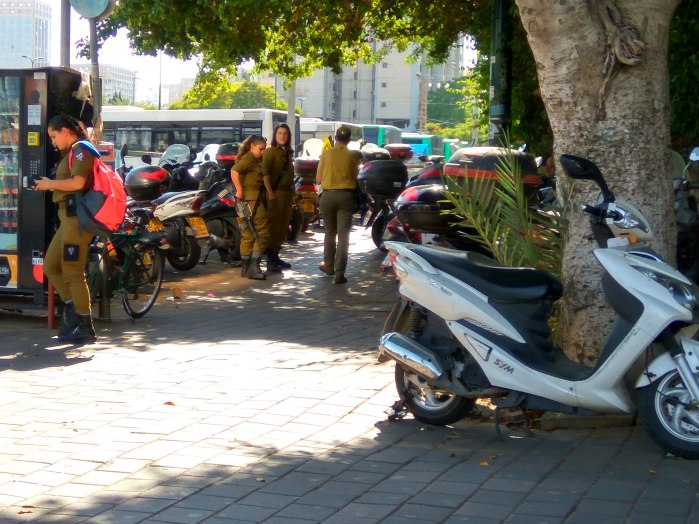
Same situation at the Central train station of Tel Aviv. The security measures are definitely higher than average.

I have to say however that showing an Italian passport usually invites friendly reactions.
After the rendez-vous with the rest of the group we moved to the Dead Sea area, where we had our meeting. The nature in the area was striking.
And I had the opportunity to include an incredible natural location such as the Dead Sea in my presentation on the Hero’s Journey. The beach was quite crowded but the effect was powerful nonetheless.

Are you familiar with the famous “Dead Sea salts“? You can buy them in many beauty shops or spa centres. They all (supposedly) come from here. The seabed is heavily excavated and a stream of trucks is always moving to and from the sea. As a result, the water level on the southern shore is dropping rapidly, and that part of the sea will soon be ever more dead.
After the conference, I moved to Jerusalem, where I was greeted by Lia, who was going to be my fantastic tour guide for the day.
Lia and me met back in 2014 in the Vision Quest course in California (the full story is here). It was really interesting to meet again after all this time, and share our respective life stories and everything that happened in the meantime.
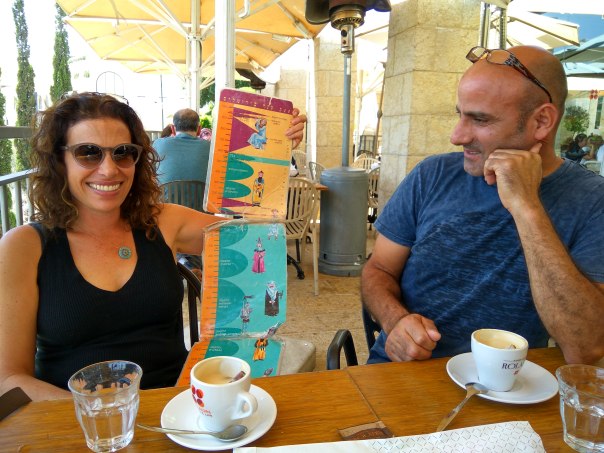
The Jaffa Gate is one of the most notable entrances to the Old City. Its actual form is owed to Suleiman the Magnificent, after the city was taken by the Ottomans in 1517.
The city walls still bear the signs of the many civilisations that succeeded in controlling the City. Different layers and styles can be seen in the sections, going from its Ancient period (credited to the king Herodes), to the ones built by the Crusaders, until the most recent, Ottoman ones.

This is one view of the actual Citadel of Zion, seen from inside Jaffa Gate.
The Old City of Jerusalem really pulsates with history. Walking around its streets had an incredibly strong impact on me. Literally every building or stone had countless stories to tell.

Layers and layers of history are everywhere ready to be discovered. This, recently discovered, is the ancient Roman Cardo (the main street) of Jerusalem.
In other words, it’s the same road where this happened:
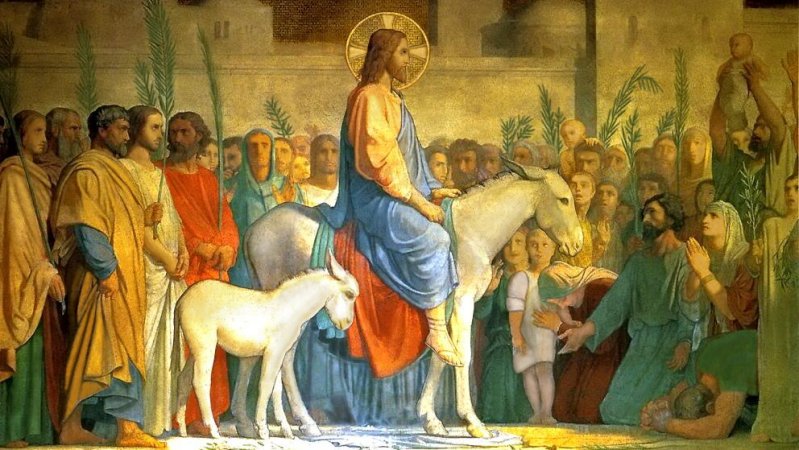
Such is Jerusalem. It’s a mixture of cultures, peoples and religions all living together side by side, and this since the beginning of times. In Hebrew only, the city is said to have something like 70 different names. The origin of the name “Jerusalem” is connected to “Foundation”, according to some sources, or to “Wholeness and Perfection”, according to others.
Sights like this are not uncommon, a minaret just next to a synagogue. Although the signs of conflicts are everywhere (Jerusalem was taken by modern Israel only in 1967), those of coexistence are much more common. It all really depends on the point of view.
(Edit: the coexistence is of course much more complicated than this. Check the comments below to know more about this particular case).
And so I got to the Temple Mount. The site is venerated as a holy site by Judaists, Christians and Muslims at the same time. According to Judaism, this is the place where the world started, and God collected the dust to create Adam.
The walls date back to king Herodes, with Byzantine additions. The Great Temple of Jerusalem was built on this hill, and destroyed two times (the last by the Romans under Tito, in 70 AD). Industrious Jews started to re-build it for the third time, but an earthquake made them change their mind.
When the city was taken by the Muslims (in 637 AD), they built the Dome of the Rock on the same site, believing this was the place from which Muhammad ascended to heaven. The huge mosque is still there, but only Muslims are allowed to enter the area now. Christians, Muslims and Judaists share a fair number of prophets in common.
A look to how the area is supposed to look like, at the times of the Great Temple.
Jews are not allowed to enter the area – and some of them wouldn’t dare anyway, since it’s believed that the presence of God is too strong there for mortal men to interfere.
That is why its walls are now used as a worship place. Men and women have to pray separately, since it is said that “men cannot concentrate on God, when women are around”. Fair point.
Prayers and wishes are left in the Wall’s cracks by anyone who feels so. I have to say that just standing under the towering walls is an impressive experience.

Jews from all over the world converge to this place to pay their homage to God.
While only Muslims can enter the Temple area and pray in the Mosque. Israeli security forces (well armed, of course) stand at every gate to stop intruders. Apparently, a quick test about Islam can be asked to verify one visitor’s faith.This is still very controversial.

And in souvenir shops, many gifts can be bought. Some are more disturbing than others.
The streets near the centre teem with life, and the markets are full with every possible merchandise or goods. Textiles, spices, incense, religious art, souvenirs are there to amaze, a wonderful sight, while the busy street sounds buzz in the air and it’s possible to hear so many spoken languages.
It’s impossible to catch in a picture all the fragrances and the sensations of a spice market. The colours will have to be enough.
And continuing with the tour, we started the Via Dolorosa, or the original “Via Crucis” as named by the Franciscans after they established in the city. By the way, the whole area is in the Arab district of the city. And it’s one of the holiest sites of the Christian faith.
The main stations are clearly marked to remind what happened there.


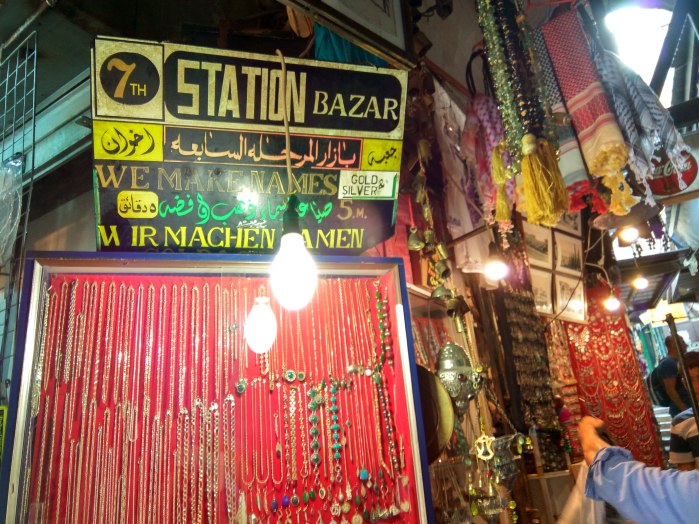
So I took the opportunity for a well deserved Felafel break. Some of the best in town, I was told.
The atmosphere in the city reminded me of (a much cleaner) Napoli, more than anywhere else. Including the restaurants in the streets, the smells, the colours and the delicious food.
And on the top of the hill, is the Church of the Holy Sepulchre, built on the (most likely) location of the crucifixion. The Church sits on the top of what once was the Golgotha, also known as Calvary hill.

Christians who want to pray at the Church are granted safety and protection since the Muslims first arrived to the city. According to tradition, Nusaybah was a female companion of Muhammad, who fought with him in battle, and is still seen as an example of women leadership in Islam.
Her Sunni Muslim family still lives in Jerusalem, and holds the keys to the Church of the Holy Sepulchre. They open and close the gate, every day, as a symbol of tolerance and dialogue between religions.
It seems that people were doing it better back then, than we do now.

And this is the actual chapel that marks the place of the crucifixion. The actual place.
In the bottom left corner, in the glass cage, the tip of the Golgotha can be seen (and touched).

And after his death, according to the witnesses, Jesus was deposed on a stone slab.
Which is still there.
And here is the actual sepulchre. What is left of the cave is not that impressive,
But what is more inspiring is the vault of the dome, with the light shining from above.
Once outside, a “bomb disposal device” (the white thing that looks like a Star Wars droid) reminds us that the Kingdom of Heaven must also face some very worldly concerns.

This concluded my tour of the Old city of Jerusalem. I have to say, I felt overwhelmed with emotions, with so much to process in such a short time. The feelings that prevailed were not at all related to fear or conflict. I have seen people of every faith and language living together side by side, running businesses, eating food. It was definitely not enough time for a deeper understanding, but all the stories I heard from people in the days before still echoed in my ears.
The Israelis I spoke with didn’t want the war. I have met people who were deeply concerned with the conflict, worried about its consequences and willing to accept the point of view of the Palestinians. I have met NGO workers and educators who bring together people from different cultures and faiths and use tools like theatre, games, sports or martial arts to help them overcome their differences. With honesty and enthusiasm.
Of course, it seems, these people are not represented by the government of their country. I am well aware of the militarism and of all the abuse – and open crimes – that are committed in the name of “peace” in that area. But what became clear to me is that the Israelis have variegated opinions on the matter (and on any other matter, actually). And that the situation has many, many layers of complexity.
Besides — isn’t the same happening all over Europe – and the world? Military lobbies and war-mongerers prevailing over the desires and the ideas of moderate, reasonable people everywhere? Apparently, as people told me, 65% of the national Israeli budget is destined to military and security forces. That’s a huge sum. NGOs struggle to find resources, as does education (which has to rely on private donors). What will be the consequences of fueling so much ignorance and hate? And at which point the feeling of “security” doesn’t become paranoia? It is definitely too much for one single person to understand.
With these feelings in mind, I also visited some of the modern parts of Jerusalem. This is the elegant and modern Jaffa street.
And this is the Post Hostel, which I definitely recommend visiting if you are planning a visit. It has a cozy atmosphere, a cosmopolitan feel, and it’s right in the centre – for reasonable prices.
*
The day after, me and my friend Lorenzo decided to go and visit Ramallah, the closest Palestinian city to Jerusalem. We started our journey from the Damascus Gate, which faces east.
Near which, by the way, it’s possible to visit the (supposed?) place of birth of the Virgin Mary.

It was a friday and buses were not running around lunch time. So we took a taxi to pass the check point (some pictures, later) and get to Ramallah.
The transfer was quite uneventful for us. Nobody stopped us or even asked for documents.
And so we got there.
The differences couldn’t be greater. Just 20 kilometers away, and we were in yet another world.

The city has a very peculiar atmosphere. A municipality since 1908, it expanded with each wave of Palestinian refugees, and particularly when people had to leave Jerusalem after it was conquered by Israel. As a result, it has a strong “boom town” feeling. Which is now part of its identity.
Our visit was important to bust some myths, and to hear first hand stories about the place. It was also important for me to get a different point of view.

First of all, religion. 30% of Palestinians are not muslim: we were visiting many areas and entire villages that lived under the Christian cross. And of course, there are also many people who don’t follow any religion in particular.
In the Mahmoud Darwish park, we met a couple right after a wedding. Their traditional dresses were wonderful.
And from there, we could enjoy an interesting view of the entire city. The park is situated in the international district of the city, where the UN and the other international organisations have their headquarters.
The international presence in the city is very strong, which leads to positive effects, and to some paradoxes as well. The influx of volunteers from abroad is big, and not everybody ends up actually doing any good there.
As locals told us in a half-joke, “Ramallah is invaded from three fronts. By the Israelis, the refugees, and the international volunteers”.
And of course, international funds mean big money. Only a part of the population can benefit from it, while others cannot, and this leads to inequalities and tensions.
All in all, it was a very interesting day. What I got is a more complete feeling of how dramatic the situation is. Palestinians live on their land but don’t have full sovereignty over it. For example, they are not allowed to dig a well to water their fields. Or – everything they import from abroad must pass through the Israeli customs (which leads to double taxes).
Palestinians cannot have an “army”, but are finally allowed to have some sort of police forces – very lightly armed. To travel abroad, they have to reach Amman (Jordan), and even then they are subject to check points and control measures that can sometimes take very long, easily resulting in missing a flight.
And Ramallah is not getting the worst of the situation. The Gaza stripe is under siege practically, and Israeli settlements – outside any international agreement – are still slowly occupying territories in the whole West Bank. It seems that the ultra-orthodox Jews that are settling there are massively funded by U.S. non governmental organisations.
Palestinians react as they can, they are not united politically – also a consequence of not having an organised “State” – and occasionally violence erupts. Some groups profit from the current situation, politically or economically (or both), and have no interest in changing it.
Currently, an offensive is under way known as the “stabbing intifada“, a conflict outbreak that has caused 217 victims since October 2015 (30 people killed by Palestinian attacks, 187 by Israeli forces). Source: this Wikipedia page.
It seems that the worst part may be over by now, which explains also why security forces did seem somewhat relaxed, on both sides.
I knew very little of all this, before going there and talking to the locals. Which tells me how insulated I am and how little information I get about the world – and I try to follow the news quite carefully.

The time of our visit was going to end, and so we visited some other places of interest in the city. I was told to try the Kanafeh while I was there, and so I put it on top of my agenda.
We visited a luxurious pastry shop in the city centre, which really looked as one of my native Napoli:

And so I got my Kanafeh! In short: it’s a devastating sugar and calory bomb (how it can be a local specialty from such a hot climate, is just another paradox of this region). A base of soft white cheese is topped with pastry and heated in butter or margarine. It is then sprinkled with fried crumbs, almonds or pistachios, and coated with a sugar syrup infused with aromas like rose water or orange blossom.
And one portion is huge! I was honestly struggling to finish it (but of course I did).
It had been a long day, and full of adventures. So we decided to end it with a moment of relax, still discussing the latest news and comparing life in Israel, Palestine and Europe.
Akram was asking us questions about Israel, and some of the impressions we had collected in the previous part of our journey.
Which left me with one last conclusion: most people in that land are enemies against their own will. They don’t trust each other (which is understandable), but they don’t know each other. The information they get is fragmented at best, and biased in many cases. And fear and prejudice are toxic obstacles on the road to dialogue.
And yet I have seen thousands of people living next to each other in Jerusalem, and the ancient culture of that city has developed many and wonderful ways to live together in peace, and even allow different faiths to coexist.
Will that corner of land ever see anything different than war and blood? If that is the favourite place of (any) God on earth, surely the All-Powerful has chosen a very strange way to manifest its sympathy. Inshallah. Some of the people I spoke with, saw better chances with the future generations. Some others were much more pessimistic.
After so many years of conflict, does it matter anymore “who started”? In my opinion, it matters much more “who will ever stop it”. That name will be written in gold letters in history. But – will I be able to see that day? Is it even possible anymore?
After the journey, I was leaving the place with many more questions than I had before.
It was time to go back. We caught another taxi,
to pass the check points back to the Israel-controlled territories of Jerusalem.
This time our passports and visas were checked, by military forces. Our taxi driver told us that other times, it’s private foreign security contractors (mainly speaking Russian) who guard the check points. And they are harder to deal with.
The feeling is certainly that of a war-torn territory.
But people there just want what everybody wants: to get on with their lives, have the possibility to go back home after a day of work, love their families, and grant a better future to their children.
And reflecting on those whishes, I could finally, really see why Jerusalem is a door to Heaven.





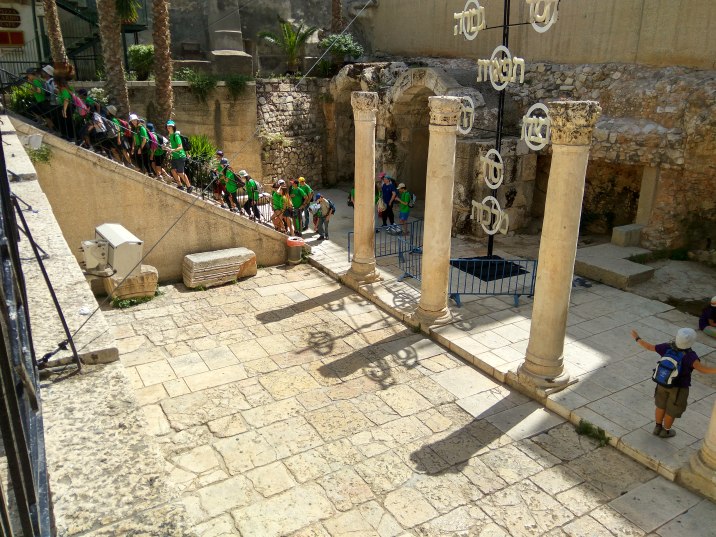










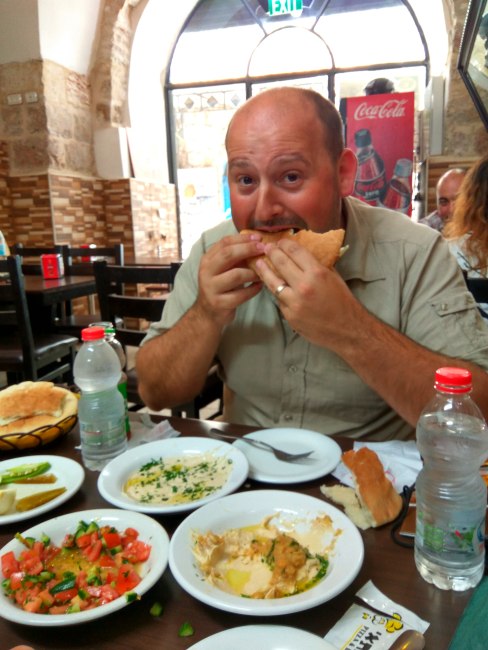








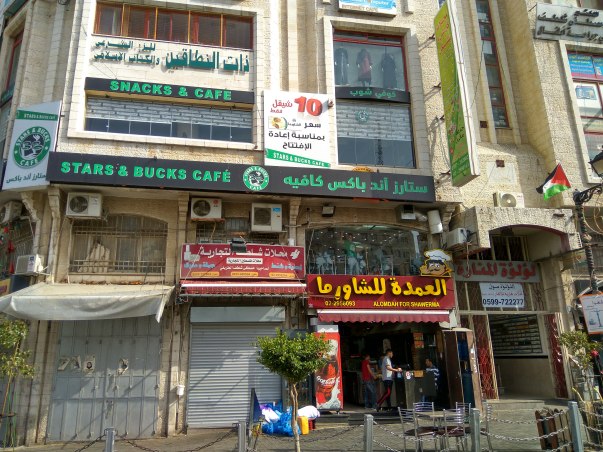








Ooooh, after reading it I also really want to go and explore the area! :)
The pictures bring a taste of the atmosphere…
LikeLiked by 1 person
I like your post a lot, but can’t resist adding one correction: in the sixteenth photo, you show a synagogue in the Jewish Quarter (the Hurva Synagogue) standing next to the minaret of a mosque, and describe the two of them as an example of co-existence. In this case, what they show is exactly the reverse of co-existence. I’ve described it this way on my own blog:
“The Wikipedia entry for the Hurva Synagogue properly mentions that its predecessors were destroyed by the Arab Legion during the 1948 War, but fails to mention that the current replacement was built adjacently to a mosque that the Israelis have closed down, rendered inoperable, and left in ruins. Apparently, mosques are not allowed to operate in the “Jewish Quarter,” but Jewish settlement in the “Muslim Quarter” is an imperative of the supposedly secular and democratically impartial Jewish State, to say nothing of the desire to build a Third Temple at the site of the Dome of the Rock.”
In fact, the Synagogue has a plaque near the front entrance stridently insisting on the fact that the Arab Legion destroyed its predecessor, but is silent about the mosque–which is not just abandoned, but covered with weeds. In fact, that sight is common throughout Jerusalem, from Lifta to the Old City: Arab ruins marginalized by the Israelis, then built over and replaced.
https://irfankhawajaphilosopher.com/about/about-the-header-photos/
LikeLike
Thank you for the comment. In fact, ignoring most of the place’s history (and history of conflict), my observations have to be seen as from an occasional bystander, and nothing more. To me, a minaret and a synagogue standing next to each other still significate that co-existance is possible. A naïve point of view probably, considering how radicalised every corner of the region is. No judgement here. Thanks a lot for the historical info :)
LikeLike